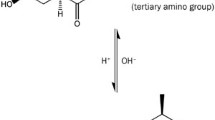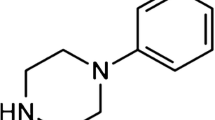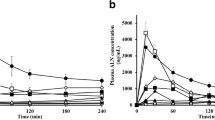Abstract
Purpose
CriticalSorb™ is a novel absorption enhancer based on Solutol® HS15, one that has been found to enhance the nasal transport. It is in clinical trials for nasal delivery of human growth hormone. The hypothesis was that permeating enhancement effects of the Solutol®HS15 component would translate to the intestine.
Methods
Rat colonic mucosae were mounted in Ussing chambers and Papp values of [14C]-mannitol, [14C]-antipyrine, FITC-dextran 4000 (FD-4), and TEER values were calculated in the presence of CriticalSorb™. Tissues were fixed for H & E staining. Caco-2 monolayers were grown on Transwells™ for similar experiments.
Results
CriticalSorb™(0.01% v/v) significantly increased the Papp of [14C]-mannitol, FD-4 [14C]-antipyrine across ileal and colonic mucosae, accompanied by a decrease in TEER. In Caco-2 monolayers, it also increased the Papp of [14C]-mannitol FD-4 and [14C]-antipyrine over 120 min. In both monolayers and tissues, it acted as a moderately effective P-glycoprotein inhibitor. There was no evidence of cytotoxicity in Caco-2 at concentrations of 0.01% for up to 24 h and histology of tissues showed intact epithelia at 120 min.
Conclusions
Solutol® HS15 is the key component in CriticalSorb™ that enables non-cytotoxic in vitro intestinal permeation and its mechanism of action is a combination of increased paracellular and transcellular flux.









Similar content being viewed by others
References
Costantino HR, Illum L, Brandt G, Johnson PH, Quay SC. Intranasal delivery: physicochemical and therapeutic aspects. Int J Pharm. 2007;337(1–2):1–24.
Illum L. Nasal drug delivery-possibilities, problems and solutions. J Control Release. 2003;87(1–3):187–98.
Ozsoy Y, Gungor S, Cevher E. Nasal delivery of high molecular weight drugs. Molecules. 2009;14(9):3754–79.
Davis SS, Illum L. Absorption enhancers for nasal drug delivery. Clin Pharmacokinet. 2003;42(13):1107–28.
Duan X, Mao S. New strategies to improve the intranasal absorption of insulin. Drug Discov Today. 2010;15(11–12):416–27.
Leary AC, Stote RM, Cussen K, O'Brien J, Leary WP, Buckley B. Pharmacokinetics and pharmacodynamics of intranasal insulin administered to patients with Type 1 diabetes: a preliminary study. Diabetes Technol Ther. 2006;8(1):81–8.
Maggio ET. Intravail™: highly effective intranasal delivery of peptide and protein drugs. Expert Opin Drug Deliv. 2006;3(4):529–39.
Illum L. Nasal drug delivery-recent developments and future prospects. J. Control. Release 2012 Jan 24. [Epub ahead of print]. PMID:22300620
Arnold JJ, Fyrberg MD, Meezan E, Pillion DJ. Reestablishment of the nasal permeability barrier to several peptides following exposure to the absorption enhancer tetradecyl-beta-D-maltoside. J Pharm Sci. 2010;99(4):1912–20.
Nepal PR, Han HK, Choi HK. Preparation and in vitro-in vivo evaluation of Witepsol H35 based self-nanoemulsifying drug delivery systems (SNEDDS) of coenzyme Q(10). Eur J Pharm. 2010;39(4):224–32.
Alani AW, Rao DA, Seidel R, Wang J, Jiao J, Kwon GS. The effect of novel surfactants and Solutol HS 15 on paclitaxel aqueous solubility and permeability across a Caco-2 monolayer. J Pharm Sci. 2010;99(8):3473–85.
Coon JS, Knudson W, Clodfelter K, Lu B, Weinstein RS. Solutol HS 15, nontoxic polyoxyethylene esters of 12-hydroxystearic acid, reverses multidrug resistance. Cancer Res. 1991;51(3):897–902.
Thayse G. Applications of Solutol(R) HS 15 (1999). http://worldaccount.basf.com/wa/NAFTA/Catalog/Pharma/info/BASF/exact/solutol_hs_15 . Accessed on December 21st, 2011.
Christopher C, DeMerlis, Goldring JM, Velagaleti R, Brock W, Osterberg R. Regulatory update: the IPEC novel excipient safety evaluation procedure. Pharm Tech. 2009;33(11):72–82.
http://www.criticalpharmaceuticals.com/news.php. Accessed January 10th, 2012.
Lewis AL, Jordan FM, Illum L. Evaluation of a novel absorption promoter for nasal delivery. Trans. 37th Int. Soc. Controlled Release Society Meeting. Abstract 93.
Maher S, Brayden DJ. Overcoming poor permeability: translating permeation enhancers for oral peptide delivery. Drug Discovery Today Technologies. 2012: doi: 10.1016/j.ddtec.2011.11.006.
Mudra DR, Borchardt RT. Absorption barriers in the rat intestinal mucosa. 3: effects of polyethoxylated solubilizing agents on drug permeation and metabolism. J Pharm Sci. 2010;99(2):1016–27.
Buckingham LE, Balasubramanian M, Emanuele RM, Clodfelter KE, Coon JS. Comparison of Solutol HS 15,Cremophor EL and novel ethoxylated fatty acid surfactants as multidrug resistance modification agents. Int J Cancer. 1995;62(4):436–42.
Maher S, Kennelly R, Bzik V, Baird AW, Wang X, Winter D, et al. Evaluation of intestinal absorption enhancement and local mucosal toxicity of two promoters. I. Studies in isolated rat and human colonic mucosae. European J Pharm Sci. 2009;38(4):291–300.
Hubatsch I, Ragnarsson EG, Artursson P. Determination of drug permeability and prediction of drug absorption in Caco-2 monolayers. Nat Protoc. 2007;2:2111–9.
Lennernas H, Palm K, Fagerholm U, Artursson P. Comparison between active and passive drug transport in human intestinal epithelial (Caco-2) cells in vitro and human jejunum in vivo. Int J Pharm. 1996;1(15):103–7.
Troutman MD, Thakker DR. Rhodamine 123 requires carrier-mediated influx for its activity as a P-glycoprotein substrate in Caco-2 cells. Pharm Res. 2003;20:1200–9.
Cornwell MM, Pastan I, Gottesman MM. Certain calcium channel blockers bind specifically to multidrug-resistant human KB carcinoma membrane vesicles and inhibit drug binding to P-glycoprotein. J Biol Chem. 1987;262:2166–70.
Decker T, Lohmann-Matthes ML. A quick and simple method for the quantitation of lactate dehydrogenase release in measurements of cellular cytotoxicity and tumor necrosis factor (TNF) activity. J Immunol Methods. 1988;115(1):61–9.
Berridge MV, Tan AS. Characterization of the cellular reduction of 3-(4,5-dimethylthiazol-2-yl)-2,5-diphenyltetrazolium bromide (MTT): subcellular localization, substrate dependence, and involvement of mitochondrial electron transport in MTT reduction. Arch Biochem Biophys. 1993;303(2):474–82.
Uchiyama T, Sugiyama T, Quan YS, Kotani A, Okada N, Fujita T, et al. Enhanced permeability of insulin across the rat intestinal membrane by various absorption enhancers: their intestinal mucosal toxicity and absorption-enhancing mechanism of n-lauryl-beta-D-maltopyranoside. J Pharm Pharmacol. 1999;51:1241–50.
Lindmark T, Schipper N, Lazarova L, De Boer AG, Artursson P. Absorption enhancement in intestinal epithelial Caco-2 monolayers by sodium caprate: assessment of molecular weight dependence and demonstration of transport routes. J Drug Targeting. 1998;5(3):215–23.
Maher S, Feighery L, Brayden DJ, McClean S. Melittin as an epithelial permeability enhancer I: investigation of its mechanism of action in Caco-2 monolayers. Pharm Res. 2007;24(7):1336–45.
Nakamura K, Takayama K, Nagai T, Maitani Y. Regional intestinal absorption of FITC-dextran 4,400 with nanoparticles based on beta-sitosterol beta-D-glucoside in rats. J Pharm Sci. 2003;92(2):311–8.
Tsutsumi K, Li SK, Ghanem AH, Ho NF, Higuchi WI. A systematic examination of the in vitro Ussing chamber and the in situ single-pass perfusion model systems in rat ileum permeation of model solutes. J Pharm Sci. 2003;92(2):344–59.
Yamashita S, Furubayashi T, Kataoka M, Sakani T, Sezaki H, Tokuda H. Optimized conditions for prediction of intestinal drug permeability using Caco-2 cells. European J Pharm Sci. 2000;10(3):195–204.
Ungell AL, Nylander S, Bergdtrand S, Sjoberg A, Lennernas H. Membrane transport of drugs in different regions of the intestinal tract of the rat. J Pharm Sci. 1998;87(3):360–6.
Griffin J, Fletcher N, Blanchflower S, Clemence R, Brayden DJ. Selamectin is a potent substrate and inhibitor of human and canine P-glycoprotein. J Vet Pharm Ther. 2005;28:257–65.
Ku S, Valagaleti R. Solutol®HS-15 as a novel excipient. Pharmaceutical Technology: 2010: 108–110. http://pharmtech.findpharma.com/pharmtech/Ingredients/Solutol-HS15-as-a-Novel-Excipient/ArticleStandard/Article/detail/694692. Accessed March, 12th, 2012.
Li M, Si L, Pan H, Rabba AK, Yan F, Qiu J, et al. Excipients enhance intestinal absorption of ganciclovir by P-gp inhibition: assessed in vitro by everted gut sac and in situ by improved intestinal perfusion. Int J Pharm. 2011;403(1–2):37–45.
Nepal PR, Han HK, Choi HK. Preparation and in vitro-in vivo evaluation of Witepsol® H35 based self-nanoemulsifying drug delivery systems (SNEDDS) of coenzyme Q(10). Eur J Pharm Sci. 2010;39(4):224–32.
Guo F, Zhong H, He J, Xie B, Liu F, Xu H, et al. Self-microemulsifying drug delivery system for improved oral bioavailability of dipyridamole: preparation and evaluation. Arch Pharm Res. 2011;34(7):1113–23.
Bravo González RC, Huwyler J, Walter I, Mountfield R, Bittner B. Improved oral bioavailability of cyclosporin A in male Wistar rats. Comparison of a Solutol® HS 15 containing self-dispersing formulation and a microsuspension. Int J Pharm. 2002;245(1-2):143–51.
Guo L, Ma E, Zhao H, Long Y, Zheng C, Duan M. Preliminary evaluation of a novel oral delivery system for rhPTH1-34: in vitro and in vivo. Int J Pharm. 2011;420(1):172–9.
Petersen SB, Nolan G, Maher S, Rahbek UL, Guldbrandt M, Brayden DJ. Tetradecylmaltoside is a permeability enhancer: isolated rat colonic mucosae in Ussing chambers. Proc Intern Symp Control Rel Bioact Mater. 38: 2011: Abstract 759.
Buckingham LE, Balasubramanian M, Safa AR, Shah H, Komarov P, Emanuele RM, et al. Reversal of multi-drug resistance in vitro by fatty acid-PEG-fatty acid diesters. Int J Cancer. 1996;65(1):74–9.
Troutman MD, Thakker DR. Rhodamine 123 requires carrier-mediated influx for its activity as a P-glycoprotein substrate in Caco-2 cells. Troutman MD, Thakker DR. Pharm Res. 2003;20(8):1192–9.
Pereira de Oliveira M, Garcion E, Venisse N, Benoit JP, Couet W, Olivier JC. Tissue distribution of indinavir administered as solid lipid nanocapsule formulation in mdr1a (+/+) and mdr1a (-/-) CF-1 mice. Pharm Res. 2005;(11):1898–1905.
Acknowledgments and Disclosures
This study was co-funded by Science Foundation Ireland grant 07/SRC B1144 and by a grant from Critical Pharmaceuticals (UK), from which ALL and LI are employees. VAB was recipient of a UCD Ad Astra Scholarship. An abstract of part of this study was presented at the AAPS Annual Meeting, New Orleans, USA (2010).
Author information
Authors and Affiliations
Corresponding author
Rights and permissions
About this article
Cite this article
Brayden, D.J., Bzik, V.A., Lewis, A.L. et al. CriticalSorb™ Promotes Permeation of Flux Markers Across Isolated Rat Intestinal Mucosae and Caco-2 Monolayers. Pharm Res 29, 2543–2554 (2012). https://doi.org/10.1007/s11095-012-0785-6
Received:
Accepted:
Published:
Issue Date:
DOI: https://doi.org/10.1007/s11095-012-0785-6




